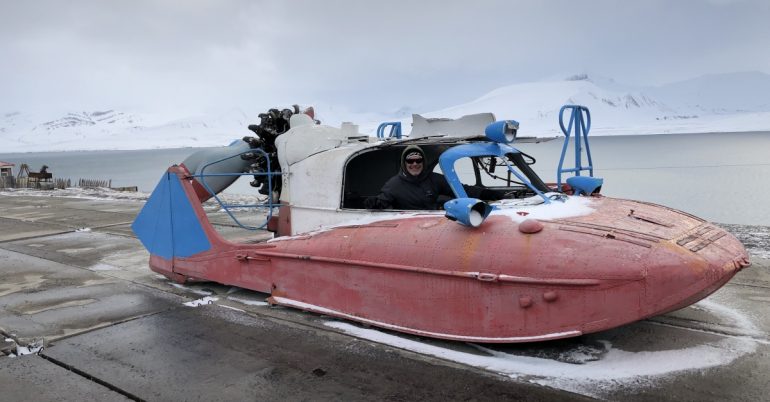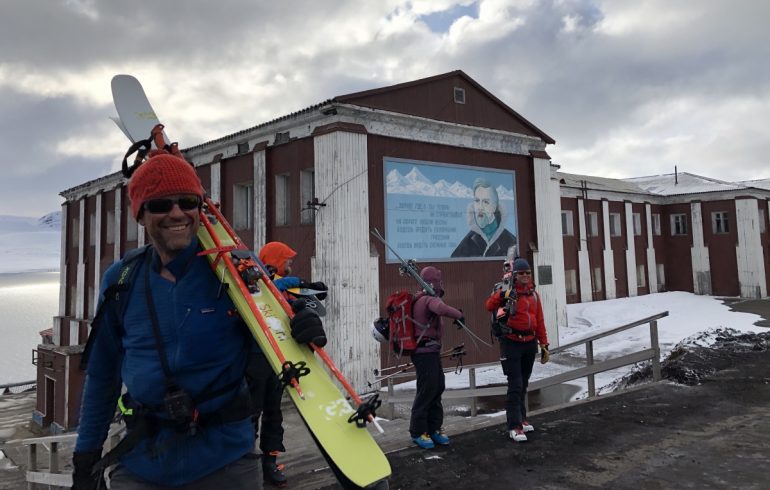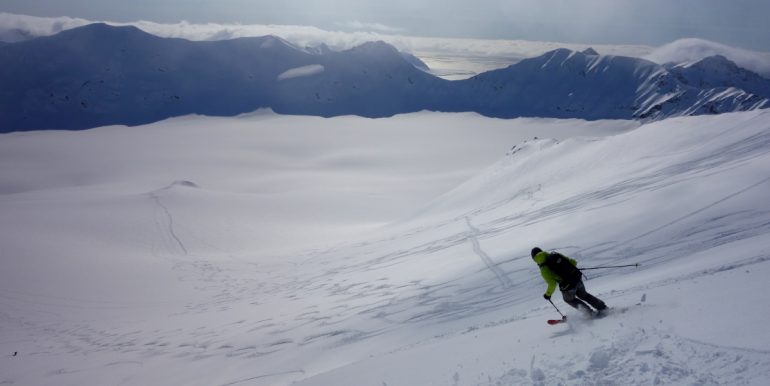Editor’s Note: It’s not just NASA that’s hot right now. The temperatures in the Northern Hemisphere are spiking as we enter the dog days of summer. While we find solace in trail runs, climbing, and mountain biking, it’s hard not to think about winter for those that are heat averse. Now might be the time to begin planning for 2022-2023 winter backcountry adventures. This piece by mountain guide Rob Copolillo first appeared on WildSnow in October 2019. Be inspired.
Adventure skiing is about so much more than snow
“Hey, it’d definitely be an adventure ski, so let me know if you’re up for it!” I catch myself saying this sometimes. People pause, reevaluate the offer. Weigh options. The calculus for adventure skiing isn’t quite as straightforward as, say, a guaranteed powder day.
Adventure skiing. Take a few seconds and define it for yourself. What does the term convey? Why not just say, “Wanna go tour together?” When does a tour become an adventure ski?
I think I use the term as part warning, part enticement, like, “Hey, I think we’re going to get the goods, but even if we don’t, it’s going to be all-time.”
Definition
As WildSnow’s official Mud Season Correspondent, I humbly offer a definition for adventure skiing: any ski or split mission during which snow quality accounts for no more than half the experience.
Sure, we all want to ski the best snow possible, but what about destinations like high-altitude peaks, remote landscapes, or improbable link-ups? Certainly these venues offer “all-time” skiing and riding in their own ways.
Any number of things can add to the adventure. How about … springtime river crossings on mossy logs? Polar bear encounters in the Arctic? High-altitude facet turns as the sun rises over the Tibetan plateau? Unspeakably good pizza in Courmayeur? Food poisoning from spoiled caviar at Megeve? Vodka shots with your helo pilot in Siberia before the flight in? Milking one more pow-run and missing the last tram ride over towards your car … and the €425 taxi ride back to Verbier. Ah, the fun you’ve had!
High- and low-lights like these color many of our best ski experiences. We tell the stories of having our passports confiscated in Montenegro with as much joy as we do the over-the-head turns at Whitecap Alpine. Adventure skiing just means factors beyond the skiing made it memorable.

King Grant, intrepid adventure skier, testing out cutting-edge 1960s speedboat technology in the post-Soviet coal town of Barentsberg, on Svalbard. Anchoring for a night in Barentsberg returned nothing in the way of ski quality, but we did run into a “skier festival” of approximately 100 Norwegians, all partying in a dilapidated bar of sorts, the “Red Bear.” They’d brought their own stand-up comic, who seemed funny, judging by the laughter of the Norwegians. The Russians refuse to pay clean-up costs for their coal mining activities, so they run a skeleton crew in Barentsberg to keep the mine “active.” The mine, near as we could tell, extracted several pick-up trucks of coal a day, enough to power the Red Bear, a local gift shop, and a Russian consulate.
Here, You Take the Gun
We regrouped for a minute and eyeballed a wide, open path onto the sea ice. Bear tracks criss-crossed the flat expanse along the coast. Mid-May on Svalbard means much of the ice has retreated, but the last few kilometers in deeper fjords still hold a floating plane of smooth, snow-covered ice. Seals sun themselves by their holes, diving in for a swim and to hunt when they so choose. The bears of course know this and walk from hole to hole, hoping to surprise a lazy seal.
From above, it’s easy to see the bear routes — and to avoid them. Nevertheless, touring on Svalbard means carrying a gun. I don’t hunt and don’t shoot with any frequency, so the idea of me skiing around with a high-powered rifle on my pack seems like a bad idea, but the Norgies require it, so here I am.
We consciously choose a wide open slope onto the sea ice, making sure there’s no potential to slide up to a bear, surprising her (and ourselves). We make it to the ice, no stress. I’m dialed, I’m smart, I am armed and I am prepared.
“Robert, I would like to tell you there is a polar bear at the site where I dropped you this morning.”
Captain Floris’s voice comes through my radio calmly, and our group immediately stops skinning. We’re headed back to the boat and probably 350m from our morning drop-off.
We alter course and arc a longer route across the ice back to an alternate pick-up, putting distance between us and the unseen bear. As we do this, a flare goes up to our left. We stop again.
“Robert, someone has scared the bear with a flare and he is now moving to the north and west.”
We are north and west of Ursus maritimus, the polar bear, a species which Wikipedia calls “hypercarnivorous.”
I drop my pack, unclip three compression straps from across the gun, quietly say to a touring partner, “Here, you take the gun.”

Tom Wolfe, IFMGA/ACMG mountain guide and owner of Sawback Alpine. Despite a layer of coal dust on everything and an icy wind, Wolfe led a gang of skiers through Barentsberg to tour on bulletproof snow above town. The group enjoyed turns back to the bar at 10 p.m., where the Norwegians had gathered steam during their festival. The mural behind Tom depicts Willem Barentsz, an early Dutch explorer, and a quote of his: “What in the hell was I thinking?”*
*Quote fabricated by author for effect.
We had agreed I would hand over the gun if things “got real,” as the kids say these days. My buddy, whom I’ll leave unnamed, is an avid hunter, owns many guns, and competently fires them. Way smarter for him to have the lethal weapon and for me to take our glorified bottle-rocket shooter, the flare gun.
The flare gun acts as a second-line defense against the bears. The first line, of course, is outright avoidance. So much for that. The camping Norwegians had used their flare gun to keep the curious bear away … and driven it right towards us.
The bear decides to circle back the other way after a minute or two, perhaps because she smelled us and decided we were too gamey, not gamey enough, or something. We breathe a sigh of relief and I take the rifle back, adding, “Don’t tell the Norwegians I gave you the gun.” My buddy laughs and we meet the Zodiac at our new pick-up, get back on the boat and watch the bear wander the ice for an hour, eventually returning to sniff our ski tracks and gaze toward our 150-foot sailboat, the Noorderlicht.
Powder Skis Won’t Help
Adventure skiing almost always implies a warning of sorts, the potential to roll the dice and come up short. Short might mean the locals don’t want you there. Or maybe the local wildlife wants to kill you. Short could be the snowpack wanting to kill you. More benignly but no less annoyingly, short could be breakable crust, rain-soaked rounds, or bottomless facets.
“I’ll just ride my powder skis,” I declared to a mentor of mine on one such bluebird but cold-ass morning in Colorado. It’d been high-and-dry for a month, meaning the paltry 70 cm of snow we had on the ground had faceted all the way to tundra, roots, and rocks. I thought 110 underfoot skis would keep me surfing snow instead of the gravel and grass above treeline on Loveland Pass.
My buddy laughed and said, “Powder skis won’t help.”
And he was right, of course. My inexperience, youthful enthusiasm, and bias towards outsmarting backcountry problems proved themselves (yet again) in the form of long, linear hieroglyphs etched into my p-tex. A few glowering core shots added an exclamation point to the whole affair.
But that said, what a day it was, facet surfing with a buddies in November, and learning something new. It was turns and trenched facets, as much as laughter and learning that made the day. Some might call riding facets a bummer (and strictly speaking, they’d be right), but just a tweak in the mindset, from pow-hunting to adventure skiing, and you gift yourself a memorable day in the mountains. Free of charge.
Adventure Skiing — We Can End Up There … if We’re Lucky
Typically you embark upon your adventure-skiing career once you’ve ticked some obvious accomplishments, and your vision of “success” broadens. If you’re lucky and committed, you might get to do the Haute Route, a couple good weeks in Canada at a lodge, an all-time winter in Colorado or Tahoe or Crystal. Then you begin looking at less obvious venues and missions, unnamed 6000 m peaks, or long traverses in spectacular locations (maybe even across sun cups with enormous packs). The experience, setting, people, landscape, and mastery matters as much as the “turns.”
Check out the film, This Mountain Life, to see what I’m talking about. Our backcountry riding can be the vehicle to meet the locals, see places, investigate ourselves, if we go beyond the Mad Pow Disease and steep skiing. Adventure skiing works worldwide, any time you can get your feet to slide on the ground beneath ‘em … and you’re open to it.
Rob Coppolillo is a mountain guide and writer, based on Vashon Island, in Puget Sound. He’s the author of The Ski Guide Manual.

